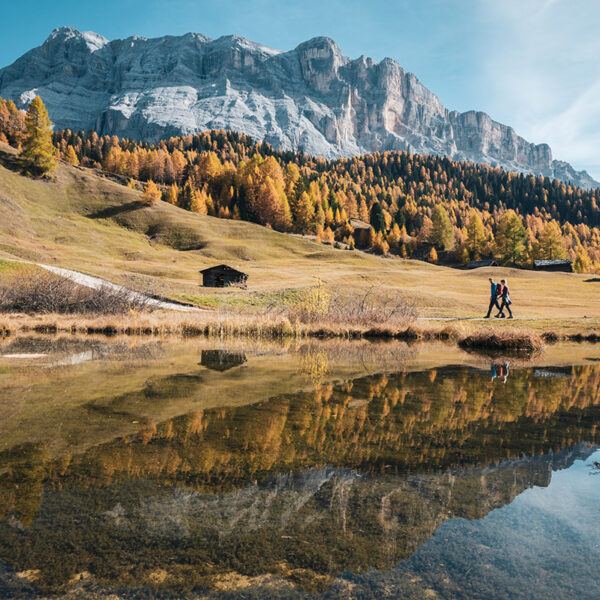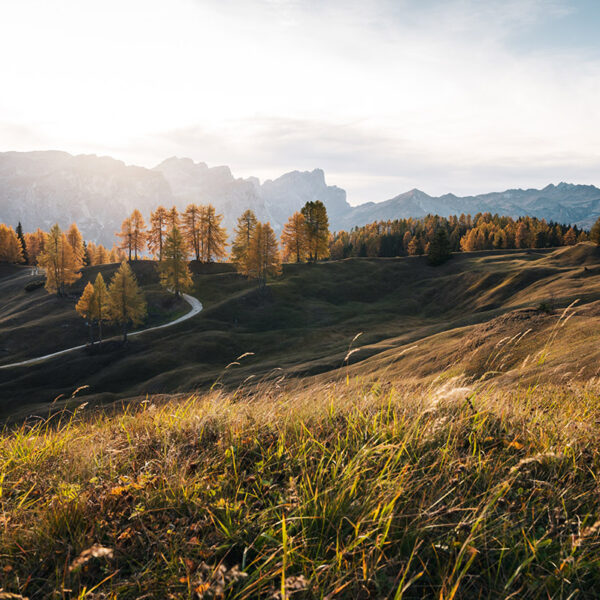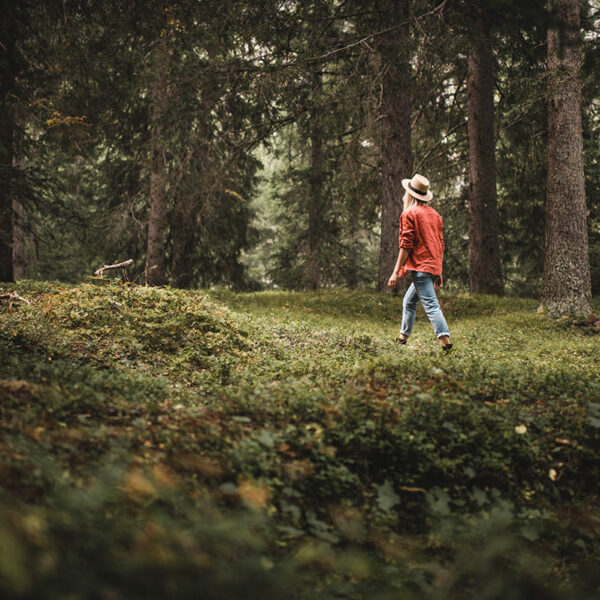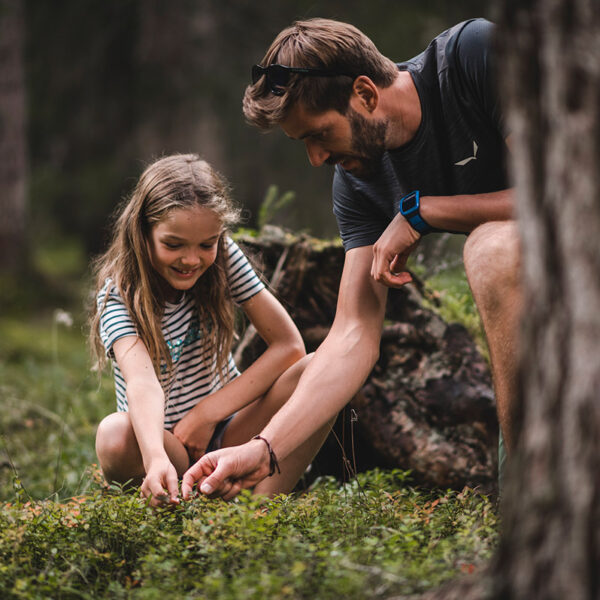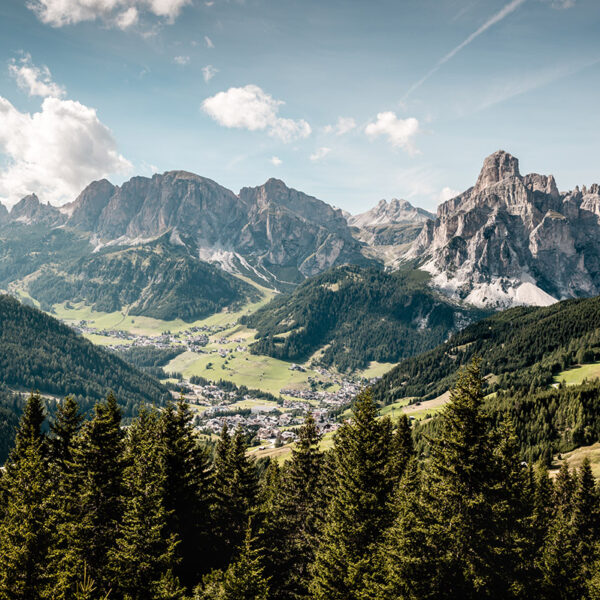Alta Badia – adüm
 Italy
Italy
Among the consequences of Storm Vaia, one of the most catastrophic is the spread of the bark beetle. This insect has reproduced on the windthrown, so much so that it is able to attack even those forests spared by the storm, multiplying the damage. In this situation, it is crucial to act promptly by skitting and cleaning the plants attacked by the bark beetle to protect the forest around the core attacked by the parasite.
Conosci le specie della Food Forest!
È una conifera maestosa che fa parte della famiglia dei pini. Ha un tronco eretto e slanciato, con una corteccia rossastra e sottile. Le foglie sono aghi verdi scuri che rimangono sempreverdi. I fiori sono coni gialli o rossi che si trasformano in frutti legnosi. Questa pianta è molto utile per la food forest perché:
– Migliora la qualità dell’aria grazie alla sua capacità di assorbire l’anidride carbonica e produrre ossigeno.
– Fornisce un legno pregiato e resistente, utilizzato per costruire case, mobili e strumenti musicali.
– Ha proprietà balsamiche, antisettiche, antireumatiche utili per curare tosse, raffreddore, dolori articolari e stanchezza.
– È una fonte di cibo e rifugio per molti animali, come scoiattoli, uccelli, cervi e cinghiali.
L’abete rosso si adatta bene ai climi freddi e continentali, ma non tollera la siccità e l’inquinamento.
È una pianta erbacea perenne appartenente alla famiglia delle Rosaceae. Ha foglie palmate e dentate, con una peluria che raccoglie la rugiada. I fiori sono piccoli e verdastri, riuniti in infiorescenze terminali. Cresce nei prati, nei boschi e nei luoghi umidi, da 0 a 2500 metri di quota. Questa pianta è molto utile per la food forest perché:
– Migliora la biodiversità del suolo grazie alla sua capacità di ospitare numerosi insetti e microrganismi.
– Fornisce un cibo medicinale per gli esseri umani, che possono usare le foglie in infusi, decotti, tinture e cataplasmi.
– Ha proprietà astringenti, antinfiammatorie, antisettiche, utili per curare ferite, infezioni, crampi e indigestione.
– È una fonte di cibo e rifugio per molti animali, come lepidotteri, coleotteri, uccelli e roditori.
L’alchemilla si adatta bene ai climi temperati e umidi, ma non tollera il caldo intenso e i terreni aridi.
È una pianta erbacea perenne appartenente alla famiglia delle Chenopodiaceae. Ha foglie ondulate e sagittate, con una peluria che rende le dita appiccicose. I fiori sono rossi o verdi, riuniti in spighe terminali. Questa pianta è molto utile per la food forest perché:
– Migliora la fertilità del suolo grazie alla sua capacità di vivere in simbiosi con batteri che fissano l’azoto atmosferico.
– Fornisce un cibo gustoso e nutriente per gli esseri umani, che possono mangiare le foglie crude o cotte.
– Ha proprietà antianemiche, vitaminiche, depurative e toniche, utili per curare anemia, carenze nutrizionali, intossicazioni e stanchezza.
– È una fonte di cibo per alcuni insetti, come le farfalle, che contribuiscono all’impollinazione.
Il buon enrico si adatta bene ai climi temperati e umidi, ma non tollera il freddo intenso e i terreni asciutti.
È una pianta erbacea e pelosa che fa parte della famiglia del caffè. Ha fiori bianchi a forma di stella che si raggruppano in infiorescenze terminali. Cresce nei prati, nei boschi e nei luoghi umidi, dove forma dei tappeti verdi. Questa pianta è molto utile per la food forest perché:
– Migliora la fertilità del suolo grazie alla sua capacità di vivere in simbiosi con batteri che fissano l’azoto atmosferico.
– Fornisce un foraggio nutriente e appetibile per gli animali domestici e selvatici.
– Ha proprietà balsamiche, espettoranti, analgesiche e antibatteriche, utili per curare tosse, bronchite, mal di testa e infezioni .
– È una fonte di cibo per alcuni insetti, come le api, che contribuiscono all’impollinazione.
Il caglio bianco si adatta bene ai climi temperati e umidi, ma non tollera il caldo eccessivo e i terreni aridi.
Questi piccoli frutti rossi, oltre ad essere dolcissimi e irresistibili, nascondono poteri segreti. Ricchi di antiossidanti, combattono i radicali liberi e proteggono le nostre cellule. Con una carica di vitamina C da fare invidia a un’arancia, rafforzano il nostro sistema immunitario e rendono la nostra pelle luminosa come un raggio di sole.
Le fragoline di bosco, con il loro effetto antinfiammatorio, sono pronte a spegnere i fuochi delle infiammazioni nel nostro corpo.
È una conifera sempreverde appartenente alla famiglia delle Pinaceae. Questa pianta è molto utile per la food forest perché:
– Migliora la qualità dell’aria grazie alla sua capacità di assorbire l’anidride carbonica e produrre ossigeno.
– Fornisce un legno pregiato e resistente, utilizzato per costruire case, mobili e strumenti musicali.
– Ha proprietà balsamiche, antisettiche, antireumatiche e stimolanti, utili per curare tosse, raffreddore, dolori articolari e stanchezza.
– È una fonte di cibo e rifugio per molti animali, come scoiattoli, uccelli, cervi e cinghiali.
Il cirmolo si adatta bene ai climi freddi e continentali, ma non tollera la siccità e l’inquinamento.
Un’altra pianta straordinaria che potrete incontrare qui è l’Equiseto. Questa pianta ha un aspetto davvero unico, con i suoi steli cavi che sembrano canne di bambù e le sue foglie piccole e affusolate. L’Equiseto è conosciuto anche come “coda di cavallo” per la sua somiglianza con la criniera di un cavallo. Ma non lasciatevi ingannare dalle sue dimensioni modeste, perché l’Equiseto ha molti talenti nascosti! È ricco di minerali benefici per la salute e le sue foglie possono essere utilizzate per preparare un tè tonificante.
È una pianta protetta in alcune regioni italiane. Fa parte della famiglia dei garofani. Ha fiori rosa o viola con petali sfrangiati che sembrano pizzi. È molto utile per la food forest perché:
– Ha proprietà antinfiammatorie, cicatrizzanti e toniche, utili per curare ferite, infiammazioni e stanchezza.
– È una fonte di cibo per alcuni insetti, come le farfalle, che contribuiscono all’impollinazione.
La garofanina di bosco si adatta bene ai climi freschi e umidi, ma non tollera il calpestio e la concorrenza di altre piante.
Questa pianta straordinaria non solo cattura l’attenzione con i suoi frutti luccicanti, ma è anche una miniera di benefici per la salute. I lamponi sono ricchi di vitamina C, potenziando il sistema immunitario come piccoli supereroi. Inoltre, contengono antiossidanti che aiutano a contrastare i danni dei radicali liberi e a preservare la giovinezza delle cellule. Con i loro nutrienti preziosi, i lamponi vi donano un tocco di magia e vitalità. Buona esplorazione!
È una conifera decidua che fa parte della famiglia dei pini. Ha un tronco eretto e slanciato, con una corteccia rossastra e sottile. Le foglie sono aghi verdi scuri che cadono in autunno. I fiori sono coni gialli o rossi che si trasformano in frutti legnosi. Questa pianta è molto utile per la food forest perché:
– Migliora la qualità dell’aria grazie alla sua capacità di assorbire l’anidride carbonica e produrre ossigeno.
– Fornisce un legno pregiato e resistente, utilizzato per costruire case, mobili.
– Ha proprietà balsamiche, antisettiche, antireumatiche e stimolanti, utili per curare tosse, raffreddore, dolori articolari e stanchezza.
– È una fonte di cibo e rifugio per molti animali, come scoiattoli, uccelli, cervi e cinghiali.
Il larice comune si adatta bene ai climi freddi e continentali, ma non tollera la siccità e l’inquinamento.
È una pianta erbacea e lanosa che fa parte della famiglia delle margherite. Ha foglie due-tre volte pennatosette con segmenti lineari e profondamente divisi. I fiori sono bianchi o rosati che si raggruppano in capolini terminali. Cresce nei prati, nei pascoli, nei boschi e nei luoghi sassosi, dove forma dei cuscini fioriti. Questa pianta è molto utile per la food forest perché:
– Migliora la biodiversità del suolo grazie alla sua capacità di ospitare numerosi insetti e microrganismi.
– Fornisce un cibo aromatico e medicinale per gli esseri umani, che possono usare le foglie e i fiori in infusi, decotti, tinture e cataplasmi.
– Ha proprietà cicatrizzanti, antisettiche, antispasmodiche, digestive, utili per curare ferite, infezioni, crampi, indigestione, mestruazioni irregolari e stanchezza.
– È una fonte di cibo e rifugio per molti animali, come lepidotteri, coleotteri, uccelli e roditori.
Il millefoglio montano si adatta bene ai climi temperati e freddi, ma non tollera il caldo intenso e i terreni umidi.
Queste piccole bacche sono ricche di antiossidanti e sostanze fitochimiche benefiche per la salute. Con il loro sapore delizioso, contribuiscono a contrastare lo stress ossidativo, proteggono le cellule e possono aiutare a prevenire infezioni urinarie. Inoltre, i mirtilli rossi sono una buona fonte di vitamina C, vitamina K e fibre alimentari, che contribuiscono a una dieta equilibrata e promuovono la salute generale.
Queste piccole bacche scure sono un tesoro di dolcezza. Il mirtillo nero è famoso per il suo contenuto di antociani, potenti antiossidanti che promuovono la salute del cuore e del sistema immunitario. Nelle foreste, è una delle specie pioniere che aiuta a preparare il terreno per altre piante, favorendo la successione ecologica.
Questa pianta affascinante, scientificamente conosciuta come Urtica dioica, può sembrare un po’ scontrosa, ma nasconde una serie di segreti nutritivi.
L’Ortica è ricca di vitamine, minerali e antiossidanti che donano forza e vitalità al nostro corpo. Le sue foglie possono essere utilizzate per preparare tisane benefiche e zuppe ricche di nutrienti.
Ma attenzione alle sue “pizzicatine”! Le sue peli urticanti possono farci fare un balzo di sorpresa, ma alcuni sostengono che possano avere proprietà stimolanti e rilassanti sulla pelle.
Lasciatevi sorprendere dalla personalità unica dell’Ortica nella nostra foresta. Buona esplorazione!
È una pianta robusta e cava che fa parte della famiglia delle carote. Ha foglie grandi e pennate che ricordano quelle del prezzemolo. I fiori sono bianchi o rosati che si raggruppano in ombrelle terminali. I frutti sono acheni oblunghi con coste prominenti. Questa pianta è molto utile per la food forest perché:
– Migliora la biodiversità del suolo grazie alla sua capacità di ospitare numerosi microrganismi.
– Fornisce un cibo saporito e nutriente per gli esseri umani, che possono consumare le foglie giovani come verdura.
– Ha proprietà digestive, espettoranti, antispasmodiche e sedative, utili per curare indigestione, tosse, crampi e nervosismo.
– È una fonte di cibo e rifugio per molti animali, come lepidotteri, coleotteri, uccelli e roditori.
Il panace comune si adatta bene ai climi temperati e umidi, ma non tollera il freddo intenso e i terreni asciutti.
Questo piccolo fiore, scientificamente conosciuto come Primula veris, è una gioia per gli occhi.
Le sue foglie e i suoi fiori sono utilizzati in tisane tradizionali per lenire la tosse e alleviare il mal di gola. Inoltre, è considerata un potente antinfiammatorio naturale.
Ma non è solo utile, è anche un vero spettacolo per gli occhi! I suoi petali gialli brillanti illuminano i prati e invitano le api a danzare intorno a loro, contribuendo alla loro impollinazione e alla promozione della biodiversità.
Questa pianta robusta, scientificamente conosciuta come Rheum rhaponticum, è un tesoro gastronomico e una risorsa per la salute.
Il Rabarbaro Alpino è noto per i suoi steli carnosi e succosi, che sono ampiamente utilizzati in dolci, marmellate e dessert. Il suo sapore agrodolce è una vera delizia per il palato.
Ma non è solo una questione di gusto. Il Rabarbaro Alpino è anche una fonte di nutrienti preziosi, tra cui vitamina C, potassio e fibre alimentari. Inoltre, contiene composti fitochimici che possono offrire benefici per la salute, come proprietà antinfiammatorie e antiossidanti.
Con la sua presenza maestosa, il Rabarbaro Alpino aggiunge un tocco di carattere alla nostra foresta.
È una pianta erbacea e striata che fa parte della famiglia delle poligonacee. Ha foglie lanceolate e dentate con un lungo picciolo quelle basali e sessili quelle cauline. I fiori sono verdastri o rossastri che si raggruppano in pannocchie terminali. I frutti sono acheni triangolari di colore rosso-bruno. Questa pianta è molto utile per la food forest perché:
– Migliora la qualità del suolo grazie alla sua capacità di assorbire i metalli pesanti presenti nel terreno.
– Fornisce un cibo gustoso e nutriente per gli esseri umani, che possono usare le foglie in insalate, minestre e salse.
– Ha proprietà depurative, diuretiche, lassative e antinfiammatorie, utili per curare ritenzione idrica, calcoli renali, stipsi e infiammazioni cutanee.
– È una fonte di cibo per alcuni insetti, come le farfalle, che contribuiscono all’impollinazione.
La romice acetosa si adatta bene ai climi temperati e umidi, ma non tollera il freddo intenso e i terreni asciutti.
È una pianta eretta e pelosa che fa parte della famiglia dei garofani. Ha fiori bianchi o rosei con un calice gonfio e membranoso che avvolge la corolla. Cresce nei prati aridi, nei campi coltivati e nei luoghi sassosi, dove resiste alle condizioni avverse. Questa pianta è molto utile per la food forest perché:
– Migliora la qualità del suolo grazie alla sua capacità di assorbire i metalli pesanti presenti nel terreno.
– Fornisce un cibo gustoso e nutriente per gli esseri umani, che possono mangiare le foglie crude o cotte.
– Ha proprietà depurative, diuretiche e antinfiammatorie, utili per curare ritenzione idrica, calcoli renali e infiammazioni cutanee.
– È una fonte di cibo per alcuni insetti, come le farfalle, che contribuiscono all’impollinazione.
La silene rigonfia si adatta bene ai climi caldi e secchi, ma non tollera il freddo intenso e i terreni umidi.
Questo piccolo fiore giallo, scientificamente conosciuto come Taraxacum officinale, è una pianta straordinaria con molte sorprese.
Il Tarassaco è famoso per la sua capacità di crescere ovunque, sfidando il terreno più ostile. È un simbolo di resilienza e determinazione, insegnandoci a stare radicati e ad affrontare le sfide con coraggio.
Ma c’è di più! Il Tarassaco è anche una miniera di benefici per la salute. Le sue foglie sono ricche di vitamine e minerali essenziali, come la vitamina A, C e K, oltre a essere una buona fonte di antiossidanti. Le sue radici hanno proprietà depurative e possono supportare la funzione del fegato.
E non dimentichiamo il suo lato giocoso! Chi non ha mai soffiato i piccoli semi del Tarassaco e fatto un desiderio mentre si spargono nel vento Il Tarassaco ci ricorda di trovare la bellezza anche nelle cose semplici della vita.
È una pianta erbacea perenne della famiglia delle Fabacee, originaria dell’Eurasia e del Nord Africa. È molto utile per la food forest perché:
– Migliora la fertilità del suolo grazie alla sua capacità di vivere in simbiosi con batteri che fissano l’azoto atmosferico
– Fornisce un foraggio nutriente e appetibile per gli animali domestici e selvatici.
– Ha proprietà medicinali benefiche per la salute umana, come antinfiammatorie, antiossidanti, estrogeniche e anticancerogene.
– È una fonte di nettare e polline per gli insetti impollinatori.
Questo albero maestoso, scientificamente conosciuto come Sorbus aucuparia, è una risorsa preziosa per la fauna e un piacere per i nostri occhi.
Il Sorbo degli Uccellatori è noto per i suoi grappoli di bacche rosse e arancioni che attirano una varietà di uccelli, da cui deriva il suo nome affascinante. Le sue bacche sono una fonte di cibo vitale per gli uccelli durante i mesi più freddi, contribuendo alla loro sopravvivenza e alla biodiversità.
Ma il Sorbo degli Uccellatori offre molto di più! Le sue foglie sono utilizzate nella medicina tradizionale per preparare tisane rinfrescanti, mentre il suo legno è apprezzato per la lavorazione artigianale.
Esplora l’eleganza del Sorbo degli Uccellatori nella nostra foresta, ammira le sue bacche luminose e fai attenzione ai canti degli uccelli che si riuniscono attorno a questo albero speciale. Il Sorbo degli Uccellatori è un simbolo di nutrimento e connessione con la natura. Buona esplorazione!
Creating new forests and accelerating their recovery by planting native species or introducing new ones to increase resilience and biodiversity is essential. But it is equally important to take care and above all protect the existing forests, because they guard a heritage of all and are very important for the absorption of CO2 that allows to mitigate the onset of extreme weather phenomena. Finding the food forest – first intervention realized to value the natural area of Passo Campolongo (Corvara, Alta Badia) – is straightforward: click here and follow the directions that will take you directly to the car park.
In a few minutes, by following the well-marked path, you will get to the hearth of the food forest. Other projects to improve and protect new forests will follow shortly. These projects will be focused mainly on the restoration of the damages caused by the storm Vaia and its consequences (in primis, the spread of bark beetle) or by other adverse climate events.
Partner of the forest










